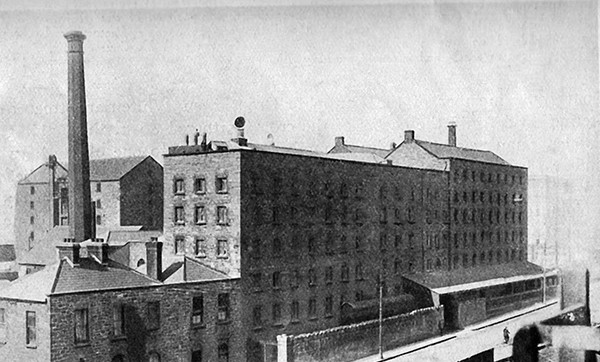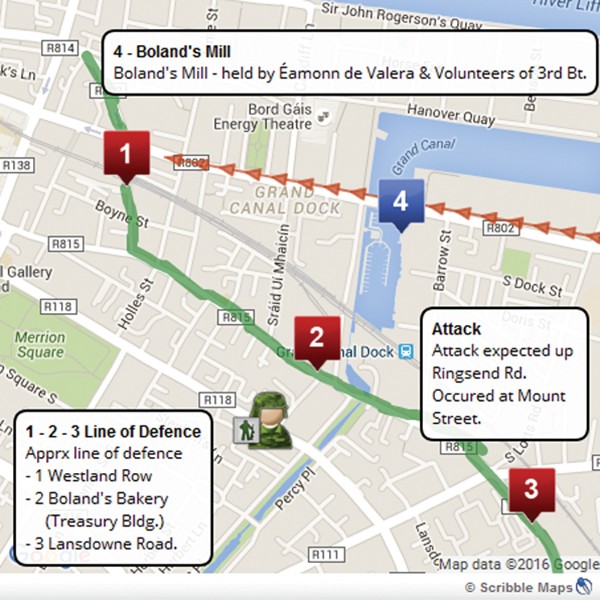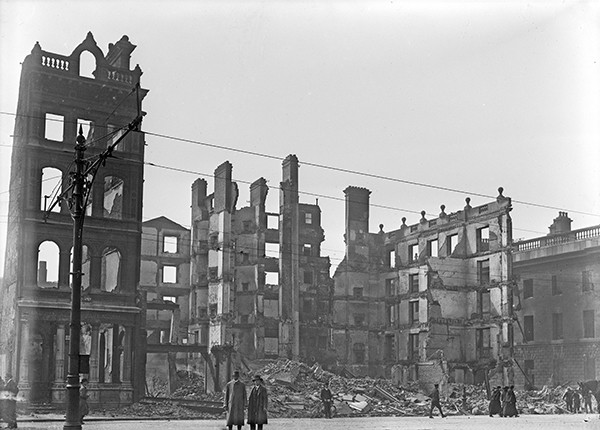
Pictured Above: A picture of Boland’s Mills from the time – courtesy of Conor McNamara.
Surely no one could have missed that this Easter is the centennial anniversary of the Easter Rising of 1916. It is being commemorated everywhere, and why not – the rising was a pivotal event in the development of this country.
As a young boy in primary school in the West of Ireland I was immersed in Ireland’s history, both in education and in environment. A copy of the 1916 proclamation of independence was on a classroom wall. Our cultural heritage, arguably from a distinctly nationalistic perspective, was a part of our education. However, the events of the rising of 1916 felt distant. There was no sense of local involvement, it all happened in distant Dublin.
Now working in Dublin 4 I can see it differently. Here the rising is remembered as a local event as much as a national one. I have been fortunate enough to hear stories from people whose family members were involved in the rising.
Every day on my way to work I pass buildings still standing that were an important part of the events of that week. Boland’s Mills is a veritable monument to the foundation of this state, and we are fortunate that it is still very much a living part of this community, now being redeveloped in a way that will preserve its usefulness and its heritage.
A couple of months ago I was asked to review a new history book by Conor McNamara, a history lecturer at NUI Galway. The Easter Rebellion 1916: A new illustrated history has been published by The Collins Press. As editor, I don’t make a habit of reviewing books for the paper, but I decided to make an exception for this one. I am a fan of high quality illustrated histories, as is this book. They are easily accessible as they appear much like coffee table books. The copious images draw the reader’s mind into the story, educating them without overwhelming them with text.
McNamara’s book is a fine example of a book that you can pick up and enjoy briefly, and pick up again later without needing to start in the same place. You can put it down after a short read, but you might not want to. Best of all, apart from its historical accuracy, is that it can engage the local reader with how their own locality fits into the history.
I took the liberty of generating a little map, based on descriptions from McNamara’s book, showing how Ringsend and Grand Canal Dock, our locality, played an important part in the rising – blocking reinforcements from Dun Laoghaire and the Beggars Bush Barracks from reaching the city centre and the GPO.

Pictured Above: Editor’s impression of the local line of defence held in Ringsend.
Almost everyone has heard the names of leading figures of the 1916 Rising, names such as de Valera, Ceannt, among others. They are mentioned here too as their importance justifies. However, McNamara goes much further and introduces us to household names in Dublin and Ireland – such as Eason, and Bewley – and how they figure into the historical landscape.
The role of women has recently been highlighted by Maria Shields O’Kelly in her article The Boys of 1916 in the Dec/Jan issue of NewsFour, when she talked with Home Instead about their commemoration of 1916. The role played by women had until recently largely been forgotten, or even airbrushed out of popular history. McNamara is helping to reverse that trend.
The topic of nationalism cannot be ignored when discussing this event. The celebrated scholar Benedict Anderson argued that all nations are created in opposition to something: it is clear that Ireland was created in opposition to British rule but, McNamara makes an important point worth noting: “Hatred of England did not inspire the small cadre who planned the Rebellion”.
In this time of commemoration we would be well served to remember the humanity of both sides and not get subsumed into hatred.

Pictured Above: The ruins of O’Connell Street in the aftermath of the rising – courtesy of Conor McNamara.
There were many tragedies during Easter week 1916, and much has been made of them to fuel hatred, but with McNamara’s balanced visual history we can make up our own minds. What I took from it was that many men fighting on both sides were poorly trained and scared, and mistakes happen.
We can all enjoy the commemoration festivities this year, and learn a little about the role our community played in the events 100 years ago. I hope understanding and compassion comes from the experience.
By Keith Murphy



